Explore the Best Rock Climbing Destinations of 2024: Top Picks Worldwide
- April 2, 2024
- 0 comment
Explore the best rock climbing spots for 2024. Find top destinations worldwide with our guide to great climbs and local cultures. Discover the top rock climbing spots for 2024 in our guide, featuring destinations from Yosemite’s iconic cliffs to Railay Beach’s stunning limestone. This guide not only highlights the best climbs but also underscores the importance of eco-friendly climbing and community engagement. Covering areas from the challenging terrains of Patagonia to the historic routes in the Dolomites, we present a selection that offers both adventure and cultural depth.

Get ready for a climbing experience that combines the excitement of the ascent with meaningful interactions with the natural world and local cultures.
List of Best Rock Climbing Destinations of 2024
- Yosemite National Park, USA
- Squamish, Canada
- Kalymnos, Greece
- Dolomites, Italy
- Railay Beach, Thailand
- Yangshuo, China
- Patagonia, Argentina and Chile
- Pedra da Gávea, Brazil
- Tafraoute, Morocco
- Waterval Boven, South Africa
What Makes a Great Rock Climbing Destination?

When it comes to defining what makes a climbing spot stand out, several factors come into play. First and foremost is the variety of routes available, catering to both beginners and seasoned climbers. A destination with a wide range of difficulty levels, types of climbs (such as bouldering, sport climbing, and traditional climbing), and unique geological features can offer a more fulfilling experience.
Scenic beauty also plays a crucial role. Climbing in a location that offers stunning views and a unique natural environment can elevate the experience from merely a physical challenge to an unforgettable adventure. Moreover, the cultural and historical significance of a climbing area can add a rich layer of meaning to your climb, connecting you to the land and its history.
Accessibility and climber-friendly amenities, such as local guides, gear rental shops, and climbers’ lodges, contribute significantly to a destination’s appeal. Furthermore, a strong commitment to sustainability and conservation ensures that these incredible sites remain accessible and preserved for future generations.
Top Rock Climbing Destinations 2024
North America
1. Yosemite National Park, USA
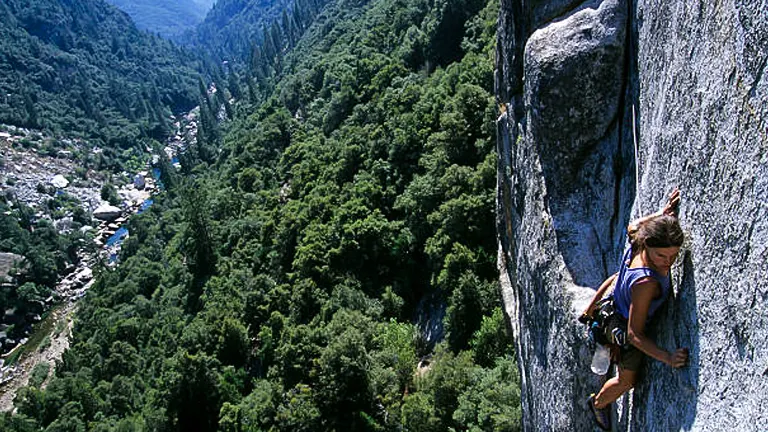
Located in the heart of California’s Sierra Nevada mountains, Yosemite is a mecca for climbers worldwide. Famous for its colossal granite walls and iconic climbs like the Nose on El Capitan, Yosemite offers routes that challenge and inspire climbers of all levels. Beyond the rock, the park’s stunning waterfalls, vast wilderness areas, and giant sequoias add to the majesty of the climbing experience.
- Size: Over 3,000 square miles of protected area with numerous climbing routes.
- Difficulty Level: Offers a wide range from beginner-friendly to expert-level challenges.
- Entrance Fee: $35 per vehicle for a 7-day pass. Climbing permits are required for some areas.
- Best Time to Rock Climb: Late spring through early fall, with peak conditions from May to October.
- Special Features: Iconic formations such as El Capitan and Half Dome; opportunity for big wall climbing.
2. Squamish, Canada
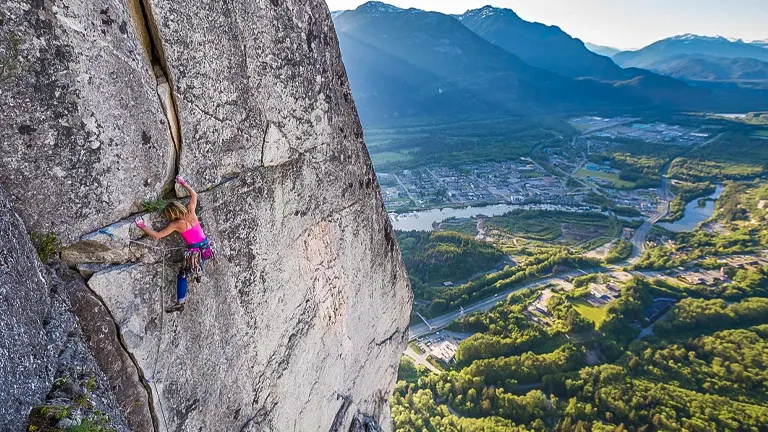
Nestled along the Sea to Sky Highway in British Columbia, Squamish is known as the “Outdoor Recreation Capital of Canada,” boasting over 2,000 climbs on impeccable granite. The Chief, the second largest granite monolith in North America, provides a stunning backdrop for climbers, with multi-pitch trad routes, sport climbs, and bouldering problems.
- Size: Hundreds of crags spread across the area.
- Difficulty Level: Ranges from easy slabs to challenging overhangs, suitable for all skill levels.
- Best Time to Rock Climb: Late spring to early fall, with ideal conditions from May to September.
- Special Features: Diverse climbing options including trad, sport, and bouldering. Proximity to Vancouver adds to the convenience.
Europe
3. Kalymnos, Greece

Kalymnos, in the southeastern Aegean Sea, has emerged as one of the world’s premier sport climbing destinations. The island’s rugged terrain is dotted with high-quality limestone crags, offering routes that are as beautiful as they are challenging. The local community warmly embraces climbers, adding to the island’s appeal.
- Size: Over 3,400 sport routes across various sectors.
- Difficulty Level: Primarily focuses on sport climbing, with routes for all levels from beginners to pros.
- Best Time to Rock Climb: Spring (March to May) and fall (September to November) offer the best weather conditions.
- Special Features: Stunning coastal views, hospitable climbing community, and the annual climbing festival.
4. Dolomites, Italy
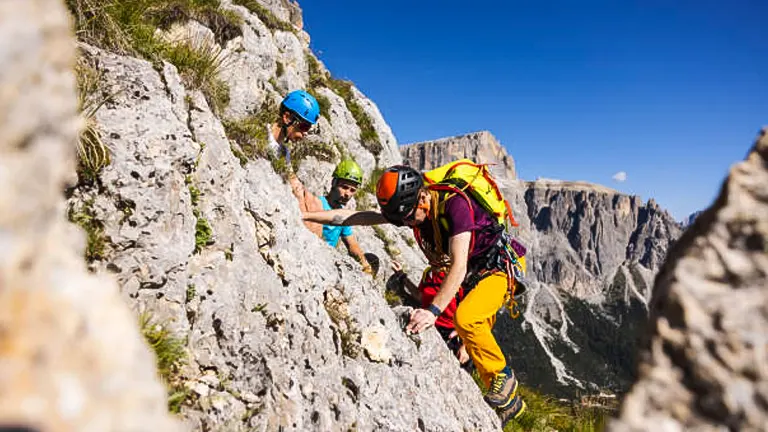
The Dolomites offer an unparalleled climbing experience, with towering peaks and spires that draw climbers from around the globe. This region combines historical routes with modern sport climbs, all set in a breathtaking UNESCO World Heritage landscape.
- Size: Thousands of routes across the Dolomite mountains.
- Difficulty Level: Wide range, including easy scrambles, challenging via ferratas, and technical alpine routes.
- Best Time to Rock Climb: Summer months, from June to September, for most routes. Some areas are accessible in spring and fall.
- Special Features: Historic climbing routes, spectacular alpine scenery, and a rich cultural heritage.
Asia
5. Railay Beach, Thailand
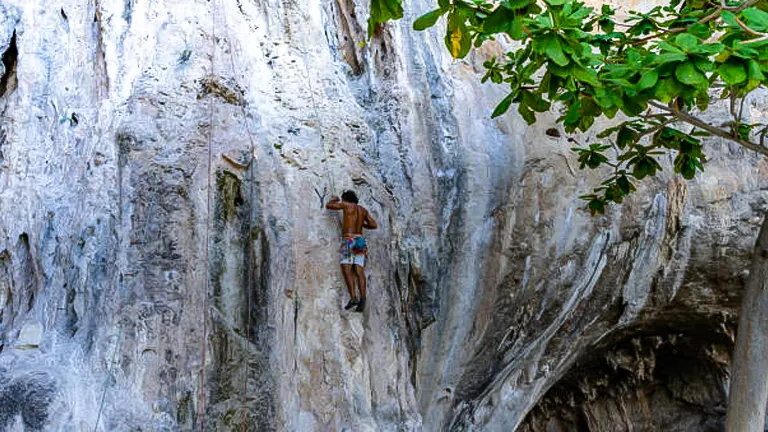
Railay Beach, only reachable by boat, is a standout rock climbing destination due to its dramatic limestone cliffs and idyllic beach setting. This area is renowned among the climbing community for its variety of routes that cater to all skill levels, from novices to seasoned climbers. Its seclusion adds to its charm, offering climbers a serene environment where the turquoise waters of the Andaman Sea meet the sky. Railay provides not just climbing opportunities but also a chance to immerse in the tranquility of Thailand’s coastal beauty.
- Size: The climbing area encompasses several cliffs along the beach and nearby.
- Difficulty Level: Routes for all levels, with a significant number ideal for intermediate climbers.
- Best Time to Rock Climb: November to April, when the weather is dry and cool.
- Special Features: Incredible beachside climbing, with the Andaman Sea providing a picturesque backdrop.
6. Yangshuo, China
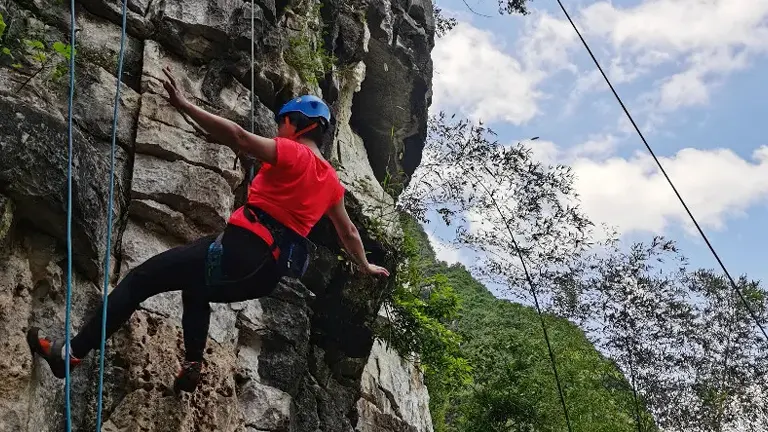
Yangshuo, set amidst China’s iconic karst mountain landscape, is a climber’s haven with over a thousand routes that traverse through its scenic vistas and lush greenery. This destination melds the allure of rural China with the thrill of climbing, offering adventurers more than just climbs but a journey through picturesque landscapes adorned with traditional villages and rice paddies. Climbers here can enjoy a variety of climbing styles against the backdrop of Yangshuo’s breathtaking mountains, making every ascent a memorable experience.
- Size: Extensive climbing areas spread across the region.
- Difficulty Level: Varied, with plenty of options for beginners to advanced climbers.
- Best Time to Rock Climb: Spring (April to June) and autumn (September to November) for the best conditions.
- Special Features: Scenic landscapes, with rice paddies and traditional villages adding to the climbing experience.
South America
7. Patagonia, Argentina and Chile
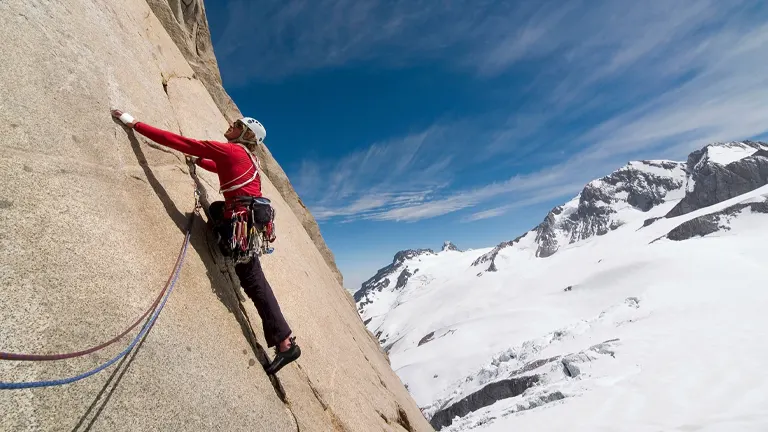
Patagonia, straddling Argentina and Chile, is a remote wilderness celebrated for its awe-inspiring mountainous landscapes and is a bucket-list destination for serious climbers. Known for its challenging routes, Patagonia requires climbers to bring their best skills to the fore. The area’s vast, untouched wilderness offers not just climbing adventures but also the opportunity to engage with nature through glacier exploration and trekking in dense forests. Patagonia’s rugged beauty and demanding climbs call to those seeking solitude and adventure in some of the most dramatic settings on the planet.
- Size: The climbing areas are spread across the Patagonian Andes, with numerous notable peaks.
- Difficulty Level: Generally advanced, with climbs requiring a high level of skill and experience.
- Best Time to Rock Climb: The Southern Hemisphere summer, December to February, offers the most stable weather conditions.
- Special Features: Remote wilderness climbing, with the chance to explore glaciers and dense forests.
8. Pedra da Gávea, Brazil

Overlooking the vibrant city of Rio de Janeiro, Pedra da Gávea offers a unique urban climbing experience that culminates with one of the most stunning panoramic views of any city worldwide. This massive granite dome challenges climbers with its steep ascent, rewarding them with breathtaking vistas of Rio’s beaches, the sprawling city, and the iconic Christ the Redeemer statue. Pedra da Gávea is more than a climb; it’s a journey through Rio’s natural landmarks, blending the thrill of the ascent with the beauty of one of the world’s most captivating cities.
- Size: The main attraction is the face of Pedra da Gávea, with several routes up the mountain.
- Difficulty Level: Intermediate to advanced, with some technical sections requiring experience.
- Best Time to Rock Climb: May to September, during the dry season, is ideal.
- Special Features: Urban climbing with stunning views of Rio de Janeiro, including the famous beaches and the Christ the Redeemer statue.
Africa
9. Tafraoute, Morocco
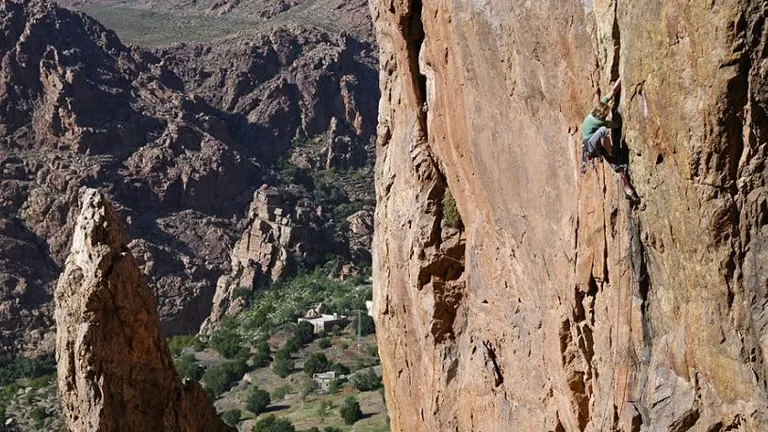
Tafraoute, set within the heart of Morocco’s Anti-Atlas Mountains, is a climber’s sanctuary known for its expansive landscapes filled with granite boulders and crags. This destination is not just about the climb but also the deep dive into the rich tapestry of Moroccan culture. Climbers here are treated to a mix of technical challenges and the opportunity to engage with the enduring Berber traditions that color the region. The climbing sites, scattered with pink granite formations, offer a surreal backdrop that contrasts sharply with the deep blue skies.
- Size: Extensive climbing areas with hundreds of trad routes and bouldering problems.
- Difficulty Level: Wide range, with many routes suitable for intermediate climbers.
- Best Time to Rock Climb: Autumn (September to November) and spring (February to April) provide the best weather.
- Special Features: The unique pink granite rocks and traditional Berber culture add to the experience.
10. Waterval Boven, South Africa
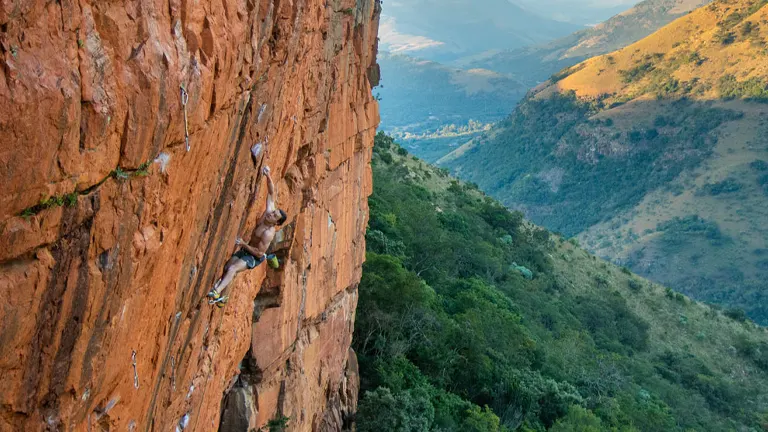
Waterval Boven, translating to “above the waterfall” in Dutch, is celebrated as one of South Africa’s climbing jewels. Situated in the Mpumalanga province, this destination draws climbers with its quality quartzite routes set amidst striking natural scenery. Beyond the diverse climbing routes, the area’s rich biodiversity and the presence of stunning waterfalls offer climbers a unique blend of adventure and natural wonder. Whether you’re a beginner or an expert, Waterval Boven provides a climbing experience that is as enriching as it is challenging.
- Size: Over 800 sport and trad routes in the area.
- Difficulty Level: Routes for all levels, from beginner to expert.
- Best Time to Rock Climb: Climbing is year-round, but the dry winter months (April to October) are best.
- Special Features: The area is not just about climbing; the waterfalls and natural scenery are also major attractions.
Each of these destinations offers a unique climbing experience, set against some of the world’s most dramatic landscapes. Whether you’re looking for beachside climbs, urban adventures, or remote wilderness challenges, the global climbing community in 2024 has something for everyone.
Preparing for Your Rock Climbing Adventure
Before you set off to conquer these world-class climbing destinations, a few key preparations can ensure a safe, enjoyable, and successful trip.
- Gear and Equipment: Ensure you have the right gear for your climbing adventure. Essential items include a reliable climbing harness, shoes that fit well, a helmet, ropes, carabiners, and a belay device. For specific destinations, specialized equipment like cams for trad climbing or a via ferrata set might be necessary.
- Skills and Training: Match your climbing skills and physical condition to the destination. Consider taking courses to brush up on climbing techniques, safety, and first aid. Indoor climbing and strength training can also prepare your body for the challenges ahead.
- Local Guides and Courses: Hiring a local guide can enhance your climbing experience, especially in unfamiliar areas. Guides can provide valuable insights into the best routes, local climbing etiquette, and safety practices. Additionally, participating in local climbing courses can offer specialized training for the area’s specific conditions.
- Travel and Accommodation: Plan your travel arrangements well in advance, considering the best season for climbing in your chosen destination. Look into accommodation options that cater to climbers, such as campsites, climbing lodges, or local hostels.
- Environmental Considerations: Practice Leave No Trace principles to minimize your impact on the natural environment. This includes packing out all trash, respecting wildlife, and staying on established trails and climbing routes.
The Future of Rock Climbing Destinations
As the popularity of rock climbing continues to grow, so does the responsibility of the climbing community to preserve these natural landscapes. Future trends in climbing destinations include:
- Sustainable Climbing Practices: There is an increasing focus on sustainable climbing to ensure that climbing areas remain intact and accessible. This includes route maintenance, managing human waste, and reducing the impact of chalk on the rock faces.
- Access and Conservation Efforts: Climbers and organizations worldwide are working to secure access to climbing areas while promoting conservation. Initiatives include land purchases, access agreements, and education campaigns about the importance of protecting natural habitats.
- Technological Advances: Advances in gear technology and climbing apps can enhance safety and provide climbers with more information about routes, conditions, and community insights. This technology can help climbers make informed decisions and prepare adequately for their climbs.
Related Post
- Explore the Top 15 Must-See Hiking Trails in Colorado for 2024: Your Ultimate Guide
- Discover the Top 15 World’s Most Spectacular Waterfalls: The Ultimate Traveler’s Bucket List
- Discover the Top 12 Mountain Bike Trails in Michigan for 2024: Ultimate Riders’ Guide
- 11 Best Horseback Riding Locations in the USA for 2024: The Ultimate Guide
- Explore the Top 12 State Parks in Alaska for 2024: Your Expert Guide
- Top 10 Camping Sites in Arizona You Need to Visit in 2024: Your Ultimate Outdoor Guide
Conclusion
Exploring the best rock climbing destinations for 2024 offers climbers an opportunity to challenge themselves, connect with nature, and experience the unique cultures of climbing communities around the globe. By preparing adequately and embracing sustainable practices, climbers can enjoy these destinations to the fullest while contributing to the preservation and appreciation of these magnificent landscapes.
FAQs
- Can I engage in sustainable tourism while rock climbing in popular destinations?
Absolutely. Sustainable tourism in rock climbing involves adhering to Leave No Trace principles, supporting local economies by hiring guides and purchasing local goods, participating in or donating to conservation efforts, and minimizing your environmental impact by using eco-friendly gear and practices. - How are climbing destinations adapting to increased traffic without compromising the natural environment?
Many climbing destinations are implementing reservation systems to limit daily visitors, creating designated trails to reduce erosion, and working with local climbing organizations to maintain routes. Education campaigns on responsible climbing practices are also becoming more prevalent to preserve the environment for future generations. - What role do local communities play in the development and preservation of climbing areas?
Local communities are crucial in preserving climbing areas through advocacy, maintenance efforts, and by fostering a sustainable tourism model that respects natural resources. They often collaborate with climbers and organizations to ensure that climbing activities contribute positively to the local economy and environmental conservation. - Are there any innovative technologies enhancing the rock climbing experience in these destinations?
Yes, from apps that provide detailed information on routes and conditions to eco-friendly climbing gear that reduces environmental impact. Advances in safety equipment and training tools also enhance climbers’ experiences, making climbing more accessible and safer for everyone involved. - How can beginners prepare for visiting these top climbing destinations?
Beginners should focus on building a solid foundation in climbing techniques, safety practices, and physical conditioning. It’s also beneficial to start with guided climbs or climbing courses in these destinations to gain confidence and experience under the supervision of experienced professionals. - What measures are being taken to ensure the safety of climbers in these top destinations amidst the challenges of climate change?
Destinations are actively monitoring weather patterns and environmental conditions to provide timely updates to climbers. Additionally, efforts to maintain and upgrade climbing routes, as well as to educate climbers on weather-related safety practices, are key strategies to address the challenges posed by climate change. - Can digital platforms and social media impact the conservation efforts of climbing destinations?
Digital platforms and social media can have a significant positive impact by raising awareness about conservation needs, promoting sustainable climbing practices, and mobilizing resources for maintenance and preservation projects. However, responsible use is crucial to prevent overexposure and overcrowding of sensitive areas. - What unique cultural experiences can climbers expect in these global destinations beyond the climb itself?
Climbers can immerse themselves in local traditions, cuisine, and festivals, offering a deeper understanding of the area’s cultural heritage. Engaging with local communities, participating in cultural exchange programs, and exploring historical sites near climbing locations enrich the overall travel experience.
Remember, each climb is not just about reaching the summit but about the journey, the people you meet, and the memories you create. So gear up, climb on, and discover the adventures that await in the world’s top rock climbing destinations in 2024.
Explore our dedicated section on national forests and state parks to uncover hidden gems and outdoor wonders.

Benjamin Brooks
Forestry AuthorGreetings! I'm Benjamin Brooks, and my journey over the past 15 years has revolved around the fascinating realms of content creation, expertise in snow clearing, and the intricate world of lumberjacking and landscaping. What began as a simple curiosity about the natural world and heavy machinery has evolved into a passionate profession where my love for crafting words intertwines seamlessly with my lumberjacking and garden skills.













Leave your comment